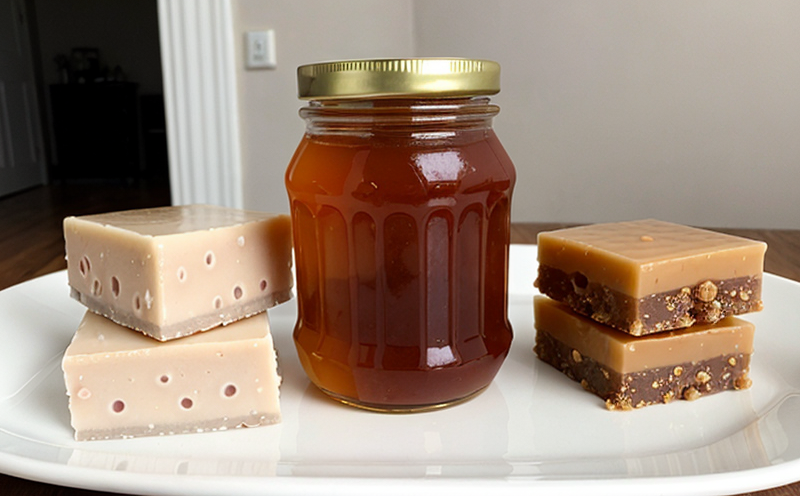Codex CAC/GL 90 Residue Analysis in Honey and Chocolate
Compliance with international standards is crucial for food and feed testing to ensure safety, quality, and regulatory adherence. The Codex Standard CAC/GL-90 provides specific guidelines for the determination of pesticide residues in honey and chocolate. This standard ensures that products meet stringent safety thresholds, thereby protecting consumers from potentially harmful chemical residues.
The process involves several critical steps including sample collection, preparation, analysis, and reporting. Samples are typically collected directly from producers or suppliers to ensure they represent the actual batch being tested. The specimens must then undergo thorough preparation to remove any extraneous materials that could interfere with the analysis. This includes sieving, homogenization, and dilution where necessary.
For honey samples, instrumental methods such as gas chromatography (GC) or high-performance liquid chromatography (HPLC) are used to detect trace levels of pesticides. Chromatographic techniques can accurately identify and quantify residues even at very low concentrations, ensuring that the final product is free from harmful contaminants.
In chocolate, the analysis targets not only pesticide residues but also other potential contaminants like heavy metals or mycotoxins. The Codex CAC/GL-90 ensures that these analyses are conducted using validated methods and standardized procedures to guarantee consistent and reliable results.
The analytical process is highly sensitive and precise, capable of detecting even minute quantities of pesticides. This sensitivity is critical for ensuring the safety of honey and chocolate products. Regulatory bodies use these test results to enforce compliance with international standards, thereby safeguarding public health.
Compliance testing under Codex CAC/GL-90 involves not just detection but also quantification. The standard specifies acceptable limits for pesticide residues based on the type of pesticide and its potential risk profile. Exceeding these limits can lead to product recall or withdrawal from the market, emphasizing the importance of accurate and reliable residue analysis.
The Codex CAC/GL-90 is widely accepted globally due to its rigorous standards and scientific approach. This ensures that the results are valid across different jurisdictions, promoting international trade and consumer confidence. Laboratories adhering to this standard must use state-of-the-art equipment and trained personnel to ensure accurate and reproducible results.
The standard's broad applicability makes it a cornerstone for quality assurance in honey and chocolate production. By following these guidelines, manufacturers can demonstrate their commitment to producing safe, high-quality products that meet the highest international standards.
Eurolab Advantages
- Expertise: Our team of experts is well-versed in Codex CAC/GL-90 and other related standards. This ensures that our testing aligns perfectly with the latest guidelines.
- Precision: Our laboratory uses advanced instrumentation to provide precise and accurate results, critical for meeting international standards.
- Rigorous Quality Control: We maintain strict quality control measures to ensure every test is conducted accurately and consistently.
- Comprehensive Reporting: We offer detailed and comprehensive reports that not only state the findings but also provide context and recommendations.
We pride ourselves on providing reliable, accurate, and compliant testing services. Our commitment to excellence ensures that our clients can trust us for their quality assurance needs.
Quality and Reliability Assurance
- Method Validation: We validate all methods used in accordance with international standards such as ISO, ASTM, EN, and IEC to ensure accuracy and reliability.
- Standard Operating Procedures: Our laboratory follows strict standard operating procedures (SOPs) to maintain consistency across all tests.
We employ rigorous quality control measures at every stage of the testing process. This includes sample preparation, analysis, and reporting. Each step is meticulously documented to ensure transparency and traceability.
Our laboratory adheres strictly to the guidelines provided by Codex CAC/GL-90, ensuring that all tests are conducted in a manner consistent with international best practices. Our commitment to quality ensures that our clients can trust the results they receive.
International Acceptance and Recognition
- Wide Acknowledgment: Codex CAC/GL-90 is widely recognized by regulatory bodies worldwide, ensuring that test results are accepted globally.
- Compliance Assurance: Compliance with this standard is a prerequisite for exporting honey and chocolate products to various markets.
The international acceptance of Codex standards enhances trade opportunities for food producers. By adhering to these guidelines, manufacturers can ensure that their products meet the stringent requirements set by importing countries. This not only facilitates smoother exports but also enhances consumer confidence in the safety and quality of the product.
Our laboratory ensures that all tests are conducted in accordance with Codex CAC/GL-90, thereby ensuring compliance and acceptance across various markets. We work closely with our clients to ensure they meet these stringent requirements, thus facilitating global trade and market access.





